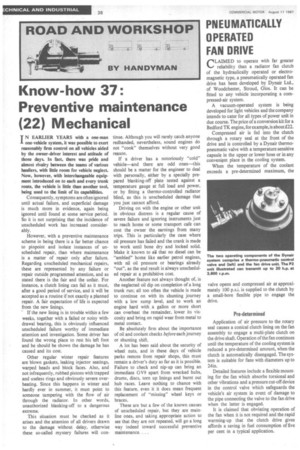PNEUMATICALLY OPERATED FAN DRIVE
Page 40

If you've noticed an error in this article please click here to report it so we can fix it.
CL AIMED to operate with far greater %–e reliability than a radiator fan clutch of the hydraulically operated or electromagnetic type, a pneumatically operated fan drive has been developed by Dynair Ltd., of Woodchester, Stroud, Glos. It can be fitted to any vehicle incorporating a compressed-air system.
A vacuum-operated system is being developed for light vehicles and the company intends to cater for all types of power unit in due course. The price of a conversion kit for a Bedford TK engine, for example, is about E22.
Compressed air is fed into the clutch through a rotary seal at the front of the drive and is controlled by a Dynair thermopneumatic valve with a temperature sensitive capsule in the upper or lower hose or in any convenignt place in the cooling system.
When the temperature of the coolant exceeds a pre-determined maximum, the valve opens and compressed air at approximately 100 psi. is supplied to the clutch by a small-bore flexible pipe to engage the drive.
Pre-determined
Application of air pressure to the rotary seal causes a conical clutch lining on the fan assembly to engage a multi-plate clutch on the drive shaft. Operation of the fan continues until the temperature of the cooling system is reduced a pre-determined amount, when the clutch is automatically disengaged. The system is suitable for fans with diameters up to 24in.
Detailed features include a flexible mounting for the fan which absorbs torsional and other vibrations and a pressure cut-off device in the control valve which safeguards the vehicle's air system in event of damage to the pipe connecting the valve to the fan drive when the latter is engaged.
It is claimed that obviating operation of the fan when it is not required and the rapid warming-up that the clutch drive gives affords a saving in fuel consumption of five per cent in a typical application.












































































































